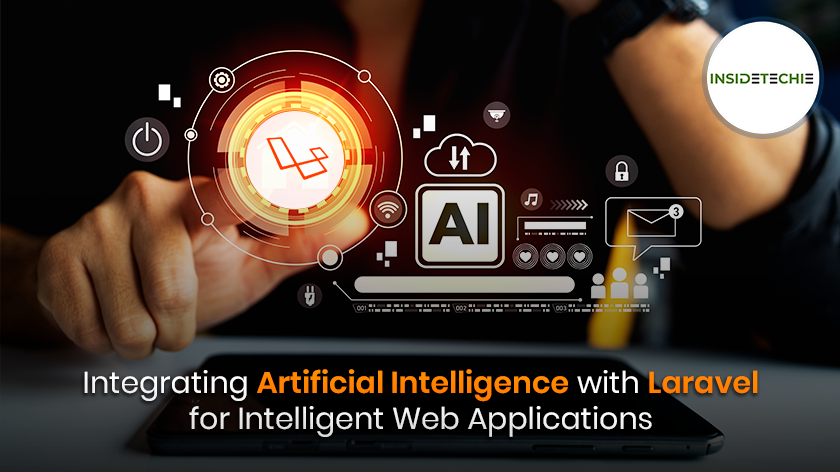Introduction of Laravel and AI
Laravel is a popular open-source PHP web application framework known for its expressive syntax, robust features, and developer-friendly tools. It provides a rich set of functionalities for building web applications, ranging from simple websites to complex enterprise-level systems.
Laravel provides powerful database tools, including an ORM (Object Relational Mapper) called Eloquent and built-in mechanisms for creating database migrations and seeders. With the command-line tool Artisan, developers can bootstrap new models, controllers, and other application components, which speeds up the overall application development.
Artificial intelligence refers to the simulation of human intelligence in machines that are programmed to think, learn, and problem-solve like humans.
AI has applications across diverse industries, including healthcare, finance, automotive, manufacturing, and entertainment, among others. It has the potential to revolutionise many aspects of our lives by automating repetitive tasks, enhancing decision-making processes, and enabling new capabilities that were previously thought to be exclusive to humans.
Integrating AI with Laravel
Integrating AI with Laravel can open up a wide range of possibilities for creating intelligent web applications. Here are some steps you might consider when integrating AI with Laravel:
1) Choose an AI Service or Library:
- Identify the specific AI functionality you want to integrate into your Laravel application, such as natural language processing (NLP), image recognition, recommendation systems, etc
- Research and select an AI service or library that provides the features you need. For example, you might use Google Cloud’s Natural Language API for NLP tasks or TensorFlow for building custom machine learning models.
2) Set Up API Integration:
- If you’re using a third-party AI service, you’ll need to set up API integration in your Laravel application to communicate with the AI service. This typically involves making HTTP requests to the AI service’s API endpoints and handling the responses in your Laravel code.
3) Implement AI Functionality:
- Once the API integration is set up, you can start implementing the AI functionality in your Laravel application. This might involve processing user input using the AI service (e.g., analysing text or images), integrating AI-driven features into your application’s user interface, or using AI algorithms to make intelligent decisions within your application’s logic.
4) Handle responses and errors:
- Handle the responses from the AI service in your Laravel application, whether it’s displaying results to the user, storing data in your database, or triggering further actions based on the AI’s output.
- Also, implement error handling to gracefully handle any issues with the AI service, such as timeouts, rate limits, or unexpected errors.
5) Testing and Refinement:
- Test the integration thoroughly to ensure that the AI functionality works as expected in your Laravel application.
- Refine the integration based on user feedback and performance metrics, iterating on the AI features to improve their accuracy and usability.
6) Optimization and Scalability:
- Consider optimizations for performance and scalability, especially if your AI integration involves heavy computation or large datasets. This might include caching results, optimising API requests, or using background processing for computationally intensive tasks.
7) Documentation and Maintenance:
- Document the AI integration in your Laravel application, including how it works, any configuration settings, and how to maintain it.
- Regularly maintain and update the AI integration as needed, keeping up with changes in the AI service or library you’re using and addressing any issues that arise.
Best Practices for AI in Laravel
When integrating AI into Laravel applications, it’s essential to follow best practices to ensure that your AI features are effective, secure, and maintainable.
Organize your code using Laravel’s modular structure to keep AI-related logic separate from other parts of your application. This helps maintain code clarity and makes it easier to update or replace AI components.
Leverage Laravel’s service providers to register AI-related services and dependencies. This keeps your code clean and allows for easy management of AI service initialization and configuration.
Use Laravel’s dependency injection to inject AI service instances into your controllers, services, or other components. This promotes code reusability and testability by decoupling components from their dependencies.
Conclusion
In conclusion, integrating AI into Laravel applications opens up a world of possibilities for creating intelligent and innovative web solutions. By harnessing the power of AI, developers can enhance user experiences, automate complex tasks, and gain valuable insights from data. Throughout this blog series, we’ve explored various aspects of integrating AI with Laravel, including: Understanding the basics of Laravel and AI, highlighting their respective strengths and capabilities. Exploring different AI tools, services, and libraries that can be seamlessly integrated into Laravel applications. Building AI-powered features in Laravel, such as chatbots, recommendation systems, image recognition, and natural language processing.
Following best practices for integrating AI into Laravel applications, including modularization, dependency injection, error handling, security considerations, and performance optimization.

